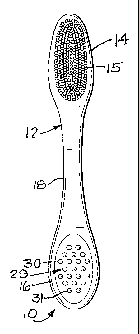Some of the information on this Web page has been provided by external sources. The Government of Canada is not responsible for the accuracy, reliability or currency of the information supplied by external sources. Users wishing to rely upon this information should consult directly with the source of the information. Content provided by external sources is not subject to official languages, privacy and accessibility requirements.
Any discrepancies in the text and image of the Claims and Abstract are due to differing posting times. Text of the Claims and Abstract are posted:
| (12) Patent: | (11) CA 2577109 |
|---|---|
| (54) English Title: | TOOTHBRUSH AND METHODS OF MAKING AND USING SAME |
| (54) French Title: | BROSSE A DENTS ET SES PROCEDES DE FABRICATION ET D'UTILISATION |
| Status: | Granted and Issued |
| (51) International Patent Classification (IPC): |
|
|---|---|
| (72) Inventors : |
|
| (73) Owners : |
|
| (71) Applicants : |
|
| (74) Agent: | MARKS & CLERK |
| (74) Associate agent: | |
| (45) Issued: | 2011-01-04 |
| (86) PCT Filing Date: | 2005-08-17 |
| (87) Open to Public Inspection: | 2006-03-02 |
| Examination requested: | 2007-02-13 |
| Availability of licence: | N/A |
| Dedicated to the Public: | N/A |
| (25) Language of filing: | English |
| Patent Cooperation Treaty (PCT): | Yes |
|---|---|
| (86) PCT Filing Number: | PCT/US2005/029137 |
| (87) International Publication Number: | WO 2006023503 |
| (85) National Entry: | 2007-02-13 |
| (30) Application Priority Data: | ||||||
|---|---|---|---|---|---|---|
|
The disclosed embodiments relate to a toothbrush and methods of making and
using it, wherein an elongated body (12) has a bristle brush head portion (14)
and a handle portion (16). The body (12) is composed of flexible material so
that the handle portion (16) can be grasped in the hand of the user, and the
user can flex the elongated body (12) into a substantially rigid position for
teeth brushing purposes.
La présente invention a trait à une brosse à dents et à ses procédés de fabrication et d'utilisation, dans laquelle un corps de forme allongée comporte une portion de tête de brosse en soies et une portion de manche. Le corps est réalisé en un matériau souple de sorte que la portion de manche peut être saisie dans la main de l'utilisateur, et l'utilisateur peut incurver le corps allongé en une position sensiblement rigide pour le brossage.
Note: Claims are shown in the official language in which they were submitted.
Note: Descriptions are shown in the official language in which they were submitted.

2024-08-01:As part of the Next Generation Patents (NGP) transition, the Canadian Patents Database (CPD) now contains a more detailed Event History, which replicates the Event Log of our new back-office solution.
Please note that "Inactive:" events refers to events no longer in use in our new back-office solution.
For a clearer understanding of the status of the application/patent presented on this page, the site Disclaimer , as well as the definitions for Patent , Event History , Maintenance Fee and Payment History should be consulted.
| Description | Date |
|---|---|
| Maintenance Fee Payment Determined Compliant | 2024-08-06 |
| Maintenance Request Received | 2024-08-06 |
| Common Representative Appointed | 2019-10-30 |
| Common Representative Appointed | 2019-10-30 |
| Grant by Issuance | 2011-01-04 |
| Inactive: Cover page published | 2011-01-03 |
| Pre-grant | 2010-10-14 |
| Inactive: Final fee received | 2010-10-14 |
| Notice of Allowance is Issued | 2010-04-15 |
| Notice of Allowance is Issued | 2010-04-15 |
| Letter Sent | 2010-04-15 |
| Inactive: Approved for allowance (AFA) | 2010-03-29 |
| Inactive: Office letter | 2009-12-21 |
| Appointment of Agent Requirements Determined Compliant | 2009-12-21 |
| Revocation of Agent Requirements Determined Compliant | 2009-12-21 |
| Inactive: Office letter | 2009-12-21 |
| Amendment Received - Voluntary Amendment | 2009-12-11 |
| Revocation of Agent Request | 2009-12-07 |
| Appointment of Agent Request | 2009-12-07 |
| Inactive: S.30(2) Rules - Examiner requisition | 2009-06-11 |
| Amendment Received - Voluntary Amendment | 2009-01-13 |
| Inactive: S.30(2) Rules - Examiner requisition | 2008-08-05 |
| Amendment Received - Voluntary Amendment | 2008-06-02 |
| Letter Sent | 2007-09-06 |
| Inactive: Single transfer | 2007-06-29 |
| Inactive: Cover page published | 2007-05-01 |
| Inactive: Courtesy letter - Evidence | 2007-04-17 |
| Inactive: Inventor deleted | 2007-04-13 |
| Inactive: Acknowledgment of national entry - RFE | 2007-04-13 |
| Letter Sent | 2007-04-13 |
| Application Received - PCT | 2007-03-06 |
| Inactive: IPRP received | 2007-02-14 |
| National Entry Requirements Determined Compliant | 2007-02-13 |
| Request for Examination Requirements Determined Compliant | 2007-02-13 |
| All Requirements for Examination Determined Compliant | 2007-02-13 |
| Application Published (Open to Public Inspection) | 2006-03-02 |
There is no abandonment history.
The last payment was received on 2010-08-09
Note : If the full payment has not been received on or before the date indicated, a further fee may be required which may be one of the following
Please refer to the CIPO Patent Fees web page to see all current fee amounts.
Note: Records showing the ownership history in alphabetical order.
| Current Owners on Record |
|---|
| LOOPS, LLC |
| Past Owners on Record |
|---|
| STEVEN L. KAYSER |